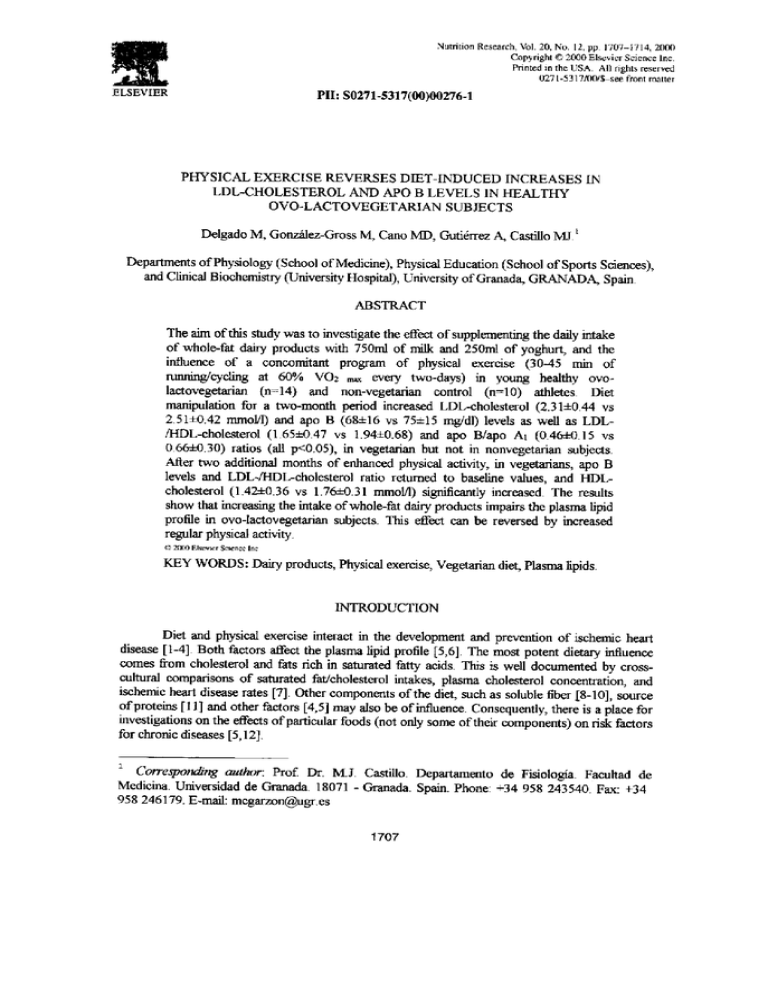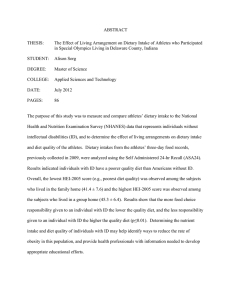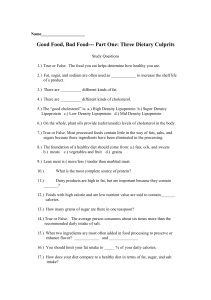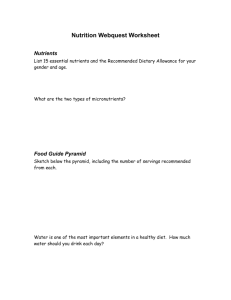
Nutrition Research, Vol. 20, No. 12, pp. 1707-1714, 2000
Copyright © 2000 Elsevier Science Inc.
Printed in the USA. All rights reserved
0271-5317/00IS-see front matter
, :~. ;i I
]ELSEVIER
Plh S0271-5317(00)00276-1
PHYSICAL EXERCISE REVERSES DIET-INDUCED INCREASES IN
LDL-CHOLESTEROL AND APO B LEVELS IN HEALTHY
OVO-LACTOVEGETARIAN SUBJECTS
Delgado M, Gonzhlez-Gross M, Cano MD, Guti6rrez A, Castillo MJ.I
Departments of Physiology (School of Medicine), Physical Education (School of Sports Sciences),
and Clinical Biochemistry (University Hospital), University of Granada, GRANADA, Spain.
ABSTRACT
The aim of this study was to investigate the effect of supplementing the daily intake
of whole-fat dairy products with 750ml of milk and 250ml of yoghurt, and the
influence of a concomitant program of physical exercise (30-45 min of
running/cycling at 60% VO2 max every two-days) in young healthy ovolactovegetarian (n=14) and non-vegetarian control (n=10) athletes. Diet
manipulation for a two-month period increased LDL-cholesterol (2.31±0.44 vs
2.51±0.42 mmol/1) and apo B (68±16 vs 75±15 mg/dl) levels as well as LDL/HDL-cholesterol (1.65±0.47 vs 1.94±0.68) and apo B/apo A1 (0.46-~.15 vs
0.66±0.30) ratios (all p<0.05), in vegetarian but not in nonvegetarian subjects.
After two additional months of enhanced physical activity, in vegetarians, apo B
levels and LDL-/HDL-cholesterol ratio returned to baseline values, and HDLcholesterol (1.42--~0.36 vs 1.76±0.31 mmol/i) significantly increased. The results
show that increasing the intake of whole-fat dairy products impairs the plasma lipid
profile in ovo-lactovegetarian subjects. This effect can be reversed by increased
regular physical activity.
© 2000ElsewerScienceInc
KEY WORDS: Dairy products, Physical exercise, Vegetarian diet, Plasma lipids.
INTRODUCTION
Diet and physical exercise interact in the development and prevention of ischemic heart
disease [1-4]. Both factors affect the plasma lipid profile [5,6]. The most potent dietary influence
comes from cholesterol and fats rich in saturated fatty acids. This is well documented by crosscultural comparisons of saturated fat/cholesterol intakes, plasma cholesterol concentration, and
ischemic heart disease rates [7]. Other components of the diet, such as soluble fiber [8-10], source
of proteins [11] and other factors [4,5] may also be of influence. Consequently, there is a place for
investigations on the effects of particular foods (not only some of their components) on risk factors
for chronic diseases [5,12].
1 Corresponding author: Prof Dr. M.J. CastiUo. Departamento de Fisiologia. Facultad de
Medicina. Universidad de Granada. 18071 - Granada. Spain. Phone: +34 958 243540. Fax: +34
958 246179. E-mail: mcgarzon~gr.es
1707
1708
M. DELGADO et al.
Vegetarian subjects present low fat and low animal protein intakes. For most of them, dairy
products represent a major source of cholesterol, saturated fat and animal protein in their diet
[ 13,14]. In fact, in vegetarian subjects, LDL-eholesterol concentrations are correlated with dairy
products and eggs consumption [15]. In these subjects, an increase in the intake of whole-fat dairy
products may have a negative effect on the plasma lipid profile.
A physiological means of influencing diet-induced modifications of the plasma lipid profile
is physical exercise. Physical activity favorably influences all three components of the atherogenic
lipoprotein phenotype: the high density lipoprotein (HDL)-cholesterol concentration may increase,
LDL-cholesterol may decrease, and serum triglycerides can also be reduced [4,6]. Therefore, the
effects of dietary-induced hypercholesterolemia may be attenuated by endurance exercise [6,16].
The aim of this study was to investigate in healthy ovo-lactovegetarian subjects a) if an
increase in whole-fat dairy products intake effectively modified the plasma lipid profile and b) if tiffs
effect could be reversed by physical exercise.
MATERIALS AND METHODS
Subjects:
Fourteen healthy ovo-lactovegetarian men were studied. Their age ranged between 18 and
25 years. They all were students or recent graduates in Physical Education. Informed written
consent was obtained from all participants and the Ethical Committee for human investigations of
our Institution approved the study. The diet of these subjects included dairy products and eggs but
not other animal products. All subjects supplied a personal and familiar medical history devoid of
metabolic or cardiovascular disease. For comparison, a matched control group of ten healthy nonvegetarians was also studied.
Procedures:
After a baseline study, all subjects from both groups accepted to have, for the next four
months, an extra daily intake of whole fat milk (750ml) and yogurt (250ml). No specific
recommendations were given concerning other nutrients. After two months, the subjects were
evaluated and then an exercise program was proposed for the next two months. The exercise
program had to be practiced in addition to their daily physical and training activities, and consisted
of a session of aerobic exercise performed once every two days. Each session consisted in running
or cycling for 30-45 rain at a minimal intensity of 60% maximal oxygen consumption (VO2 ~,).
These training sessions were done in the laboratory, under the presence of one of the investigators.
At the end of these two months the subjects were re-evaluated. Evaluations consisted of a) control
of food intake, b) estimated energy expenditure, c) anthropometric measurements, d) assessment of
aerobic capacity and e) analysis of the plasma lipid profile.
a) The control of food intake was evaluated along the study by two different means: 1. Diary. In
this diary, the subjects kept a 7-day dietary record during the week before the study (baseline), 8th
week (diet) and 16th week (diet + exercise). Previously, they were instructed how to calculate in
grams the food portions. These data were introduced in the computer program, analyzed and
presented in a dally base. 2. Questionnaires. At entrance, the subjects completed a questionnaire
indicating their dietary habits. In addition, during the study, another questionnaire was completed
once a week, indicating the food consumed in the previous 24 hours with particular emphasis to
dairy products. This intended to check if they were fulfilling the prescribed protocol. The dietary
records were analyzed by a computer program and nutrient database adapted to the local diet
[ 17,18]. Throughout the study period, weekly personal interviews were held with each subject to
reinforce compliance. The increases in dairy products intake and physical activity were well
tolerated by all subjects.
b) The quantification of physical exercise as energy expenditure was done by two different means:
1. Diary. In this diary, the subjects wrote down all the physical and sport activities performed
BLOOD LIPIDS IN VEGETARIANS
1709
before beginning with the study (baseline), during the 8th week (diet) and during the 16th week
(diet + exercise). 2. Questionnaires. At entrance, the subjects completed a questionnaire indicating
their usual physical exercise pattern. In addition, during the study, another questionnaire was
completed once a week, indicating the physical and sport activities during the previous 24 hours,
including hours of slecla, hours of sitting (or no physical exercise) and hours of slight, moderate or
high physical activity. This information was processed in the computer program that uses as
database the energy expenditures of industrial, technical and leisure time activities [ 19]. Although
some comments have been made about the use of these values [20,21], they can be considered still
up to date.
c) Anthropometric measurements included weight, height, skinfolds thickness, and circumference
of arm and leg. Body composition was also determined by near-infrared technology (Futrex 5000).
d) Aerobic capacity was determined using a Med-Graphics Cardiopulmonary Exercise System CPX
(St Paul, MN).
e) Blood samples for the plasma lipid profile analysis were drawn in the morning after a fast of 12
to 15 h. Plasma cholesterol and triglycerides were measured by enzymatic methods adapted to a
Technicon Dax 72 Autoanalyzer (Terrytown, NY). HDL-cholesterol was determined after
manganese and heparin precipitation of low and very low density lipoproteins. LDL-cholesterol
was estimated by the Friedewald formula [22,23]. Apolipoprotein B and A1 levels were measured
by immunonephelometry (Beckman Immunochemistry System, Brea, CA). The interassay
coefficients of variation for these two assays were, respectively, 4.2% and 4.8% [24]. All the assays
were performed in the General Clinical Laboratory of the University Hospital. No information was
provided to the laboratory concerning the characteristics and eating patterns of the subjects. The
Regional Health Authority guaranteed quality control procedures. Time-related variations in the
assays were excluded by daily analysis of control sera.
Statistics._
One-way analysis of variance was used to evaluate overall group differences. The Student-t
test for either paired or non-paired data was employed to compare pairs of means. Results are
expressed as mean+SD, p<0.05 was considered significant.
Table 1. Mean ± SD daily intakes of several dietary components evaluated at baseline, after two months of
supplemented dairy product intake (Diet) and after two additionalmonths of enhanced training (Diet+Exercise),in
healthy ovo-lactovegetarian(n=14) and non-vegetarian(n=10) control subjects.
Energy intake (kcal)
Proteins (g)
Carbohydrates(g)
Fat (g)
Saturated (g)
Monounsaturated (g)
Polyunsaturated(g)
P/S ratio
Cholesterol (g)
Fiber (g)
Ovo-lactovegetariansubjects
BASELINE
DIET
DIET +
EXERCISE
3035+754 3461+798' 3542_+569"
84±25
120±23'
114±17"
413±126 430+150
439+111
103-+34
142±39"
150±27"
31±14
63±20"
70±14"
51±17
57+19
58+14
20+11
22±13
22-+11
0.67±0.36 0.37-+0.24" 0.33+0.25"
257-+106 423+116' 441-+82"
22_+9
24±8
26±10
Non-vegetarian
control subjects
BASELINE DIET
DIET ÷
EXERCISE
3598_+900 3860+894 3941_+866
124+25§ 145+17'§ 154±18"§
441-+113 425+111' 432+120
164±58§ 1 7 5 ± 4 8
173±51
54±25 §
65+22'
75+22"
86±36 §
90-+32§
75+37
22+7
21+6
23±6
0.44+0.13 0.34+0.10" 0.33+0.13"
839_+557
§ 906+355~i 895±468§
17±9
16_+6
16±8
* p<0.05 vs Baseline. 11p<0.05 vs Diet. §p<0.05 vs ovo-lactovegetariansubjects.
171 0
M. DELGADO et al.
RESULTS
Daily intakes of different dietary components for the two groups of subjects are given in
Table 1. At baseline, ovo-lactovegetarian subjects presented lower protein, fat (saturated and
monounsaturated) and cholesterol intake than non-vegetarian control subjects. The ratio
polyunsaturated/saturated (P/S) fat tended to be (p=0.07) higher in the vegetarian, group. The diet
manipulation increased the intakes of protein and saturated fat in both groups. P/S ratio decreased
in both groups. Cholesterol intake increased significantly only in the vegetarian group, although it
did not reach the high intakes of the non-vegetarian group.
BMI was similar in both groups but percent of fat body mass and percent of lean body mass
were respectively lower and higher in the vegetarian group (Table 2). After dietary manipulation,
body weight increased slightly in the non-vegetarian control group but not in the vegetarian group.
After the period of enhanced physical activity, a decrease in fat body mass was observed in both
groups. As could be expected, energy expenditure increased, although slightly, during this
enhanced training period. Physical performance was similar in both groups and was not modified
during the study. A slight increase in maximal aerobic power could be observed at the end of the
study for the non-vegetarian group (Table 2).
Table 2. Mean +_SD daily physical characteristics evaluated at baseline, after two months of supplemented dairy
product intake (Diet) and after two additional months of enhanced training (Diet+Exercise), in healthy ovolactovegetarian (n=14) and non-vegetarian (n=10) control subjects. Height was similar in both groups (179±7 vs
177+_5cm). MAP = maximal aerobic power.
Ovo-lactovegetarian subjects
BASELINE
DIET
DIET +
EXERCISE
B.M.I.
Body weight (kg)
22+0.5
69.3±7.9
22+0.5
22+0.5
69.5+_7.8 69.2+7.9
Fat body mass (%)
10.0±0.6
10.0_+0.5
Lean body mass (%)
49.8±2.4
50.5+-2.9 50.4+-3.0
Non-vegetarian control subjects
BASELINE DIET
DIET +
EXERCISE
23+0.9
23±0.6
69.6+_7.2 70.6±7.5"
9.9-.0.611 10.7+-1.2§ 10.4-.1.0
55+6
293±37
56+_5
293-*37
56-*6
300-*46
70.1+7.7
10.3-.1.3'
47.2±1.1§ 48.3+_1.2§ 48.8±1.3
Energy expenditure (kcal/day) 4138+_491 4047+390 4231+_4901 4110+_389 4080±368
VO2,,~, (mL.kg-l.min 1)
MAP (watts)
23±0.6
51_+8
270±42
50+7
270±42
4177+337 "1
53-*9
290-*46'11
' p<0.05 vs Baseline. 11p<0.05 vs Diet. § p<0.05 vs ovo-lactovegetarian subjects.
The plasma lipid profile during the different study phases for both groups of subjects are
given in Table 3. At baseline, vegetarian subjects, compared to non-vegetarian, only presented
significant lower ape B levels. After the first two months of dietary manipulation, the evolution of
the plasma lipid profile differed in both groups. In the vegetarian group the increase in dairy
products intake induced significant increases in LDL-cholesterol and ape B levels, as well as in
LDL-/HDL-cholesterol and ape B/ape A1 ratios. In the non-vegetarian control group, the diet
manipulation did not significantly affect the plasma lipid profile (Table 3).
The increase in physical activity had a positive influence on both groups. In vegetarian
subjects, physical exercise reduced LDL-cholesterol and ape B levels, and increased significantly
HDL-cholesterol levels, although this was not accompanied of a similar effect on ape A1 plasma
concentration. Consequently, LDL-/HDL-cholestcrol, but not ape B/ape A1 ratio, returned to
baseline values. In the non-vegetarian control group, the training program also induced significant
reductions in LDL-cholesterol and ape B levels (Table 3).
BLOOD LIPIDS IN VEGETARIANS
1711
Table 3. Plasma lipid profile values (mean ± SD) measured at baseline, after two months of supplemented dairy
product intake (Diet) and after two additional months of enhanced training (Diet+Exercise), in healthy ovolactovegetarian (n=14) and non-vegetarian (n=10) control subjects.
Total cholesterol (mmol/L)
LDL-cholesterol(mmol/L)
HDL-cholesterol(mmol/L)
LDL-/HDL-cholesterol
Triglycerides(mmol/L)
Ape B (mg/dL)
ApoAl (mg/dL)
Ape B/Ape AI
Ovo-lactovegetarian subjects
BASELINE
DIET
DIET ÷
EXERCISE
Non-vegetarian
control subjects
BASELINE DIET
DIET +
EXERCISE
4.17±0.48
2.31±0.44
1,45±0.26
1.65±0.47
0.90+0.42
68±16
140_+41
0.46±0.15
4.43+0.45 4.44+0.77 4.24+0.55
2.52±0.35 2.47+0.53 2.30+0.32*
1.58÷0,40 1.59+0.42 1.60±0.42
1.67+0.41 1.67+0.57 1.51±0.37
0.71+0,18 0.84±0.33 0.72±0.15
85±14 §
86+18
78±12'
153+28
164+47 138±41
0.58±0.16 0.56±0.16 0.64±0.28
4.33±0.53
2.51±0.42'
1.42+0.36
1.94±0.68'
0.87±0.29
75±15'
132+49
0.66±0.30'
4.38±0.60"
2.40±0.51
1.76+0.31"t
1.60+0.501
0.85±0.23
68±131
125+34
0.57±0.11
"p<0.05 vs Baseline. ! p<0.05 vs Diet. § p<0.05 vs ovo-lactovegetarian subjects.
DISCUSSION
The initial premise of this study was to include food pattern differences (higher intake of
dairy products), as well as nutrient differences (higher intakes of cholesterol, saturated fat and
animal protein), and to investigate the effect on the plasma lipid profile in a group of subjects
presenting low intakes of those nutrients. At least in theory, vegetarian subjects could be more
sensitive to this type of diet manipulation. Similarly, the positive effect of simultaneous physical
exercise, if present, could be more easily appreciated. The results here presented show that in
healthy young and physically active ovo-lactovegetarian subjects, an increase in dairy products
intake, consisting in 750ml of whole fat milk and 250ml of whole fat yogurt, added to their daily
diet, deteriorated the plasma lipid profile. This effect was reversed by a simultaneous increase in
physical activity.
Compared to non-vegetarian control subjects, the vegetarian group had a similar level of
physical activity but tended (p=0.1) to have a lower total energy intake. Nevertheless, body weight
was similar in both groups. This discrepancy could be obviously explained by under- or overreporting during dietary anamnesis, but seven days recall and food frequency questionnaires were
highly concordant. Decreased lipid oxidation in vegetarians, which is associated to decreased fat
stores [25], may be an alternative explanation. Although the diet manipulation increased total
energy intake and the program of physical exercise increased energy expenses, body weight in the
vegetarian group was unaffected. Several reasons can be argued. The adjustment of energy
expenditure and substrate oxidation to energy and substrate intakes constitutes an essential process
in the maintenance of whole-body homeostasis [26]. Variations in energy intakes are partly
compensated by down-regulation of basal metabolic rate, and this is better related to the fat-free
mass [23,27]. In addition, diet-induced thermogenesis is increased with higher protein and fat
intake.
Modifications of total fat intake and changes in the type of fat consumed may affect the
plasma lipid profile, especially in subjects with low intake of saturated fat and cholesterol, such as
vegetarian subjects. In these subjects, the restrictions of a vegetarian diet result in a smaller number
of foods to be assessed for saturated fat and cholesterol content. Consequently, evaluation of
1712
M. DELGADO et al.
dietary lipid consumption is easier and, likely, more accurate [15]. In addition, the low range of
cholesterol and saturated fat intake of these subjects may be the range in which plasma lipids are
more easily influenced by dietary changes.
Diets providing a high percentage of energy derived from fat, as well as diets rich in
saturated fat or with a low P/S ratio, generally induce elevations of both LDL- and HDLcholesterol levels [28]. Such diets increase LDL-cholesterol more than HDL-cholesterol levels.
This results in a less favorable LDL-/HDL-cholesterol ratio. Our data show that in ovolactovagetarian subjects, increasing the intake of dairy products results in increases in both LDLcholesterol and apo B concentrations, with no change in HDL-cholestcrol. This cannot be
attributed to a time-trend effect since the control group was studied in parallel and these variations
were not observed.
In strict vegetarians, it has been reported that plasma LDL-eholesterol levels are correlated
with the consumption of dairy products [15]. ~
fat contains some of the most commonly
consumed saturated fatty acids, such as laurie (C12:0) and myristie (C14:0) acids, that have a more
pronounced influence on plasma cholesterol [28]. Fatty dairy products are also rich in cholesterol,
which may increase LDL-cholesterol levels [29]. Our results agree with these and other [30]
studies.
Regular physical exercise may offset the effect of high intakes of cholesterol, saturated fat
or other dietary components on the plasma lipid profile [4,6]. It has been demonstrated that aerobic
conditioning prevented the rise in plasma cholesterol during short-term egg feeding [31]. On the
other hand, moderate physical conditioning, in initially sedentary middle aged men, induced
significant increases in HDL-cholesterol levels [32,33]. A small number of studies have analyzed
the opposite effects of both dietary modifications and training programs on the plasma lipid profile
of well-trained subjects. Kiens et al [34] found no modification in HDL-cholesterol in healthy, welltrained men who consumed a fat-rich diet for 4 weeks, followed by 4 weeks of a fat-poor diet. In
physically active subjects, dietary modifications probably require longer periods to induce
significant changes in the plasma lipid profile [35]. In addition, the threshold of exercise necessary
to modify the plasma lipid profile may differ in sedentary and non-sedentary subjects [36,37]. In any
case, regular physical exercise of moderate intensity helps to prevent dietary-induced changes in the
plasma lipid profile. Our results dearly show the ability of exercise to reduce serum lipids of
vegetarians consuming high levels of whole-fat dairy products.
In conclusion, a supplemented intake of whole-fat dairy products in healthy young ovolactovagetarian subjects increases LDL-cholesterol and apo B levels. This effect can be reversed by
moderately intense regular physical exercise, which, in addition, increases HDL-eholesterol levels.
REFERENCES
1. Leon AS. Physiological interactions between diet and exercise in the etiology and prevention of
ischaemie heart disease. Ann Clin Res 1988;20:114-1201
' 2. Colt EWD, Hashim S. Effect of exercise and diet on lipids and cardiovascular disease. Curr
Concepts Nutr 1986;15:117-143.
3. Kannel WB, Wilson PWF. Efficacy of lipid profiles in prediction of coronary disease. Am Heart
J 1992;124:768-774.
4. Ordovas JM. The genetics of serum lipid responsiveness to dietary interventions. Proc Nutr
Soc 1999; 58:171-87.
5. Fraser GE. Diet and coronary heart disease: beyond dietary fats and low-density-lipoprotein
cholesterol. Am J Clin Nutr 1994;59(suppl): 1117S-23S.
6. Berg A, Frey I, Baumstark MW, Halle M, Keul J. Physical activity and lipoprotein lipid
disorders. Sports Med 1994;17:6-21.
7. Stamler J, Shekelle R. Dietary cholesterol and human coronary heart disease. The
BLOOD LIPIDS IN VEGETARIANS
1713
epidemiologic evidence. Arch Pathol Lab Med 1988; 112:1032-40.
8. Singh RB, Rastogi SS, Niaz MA, Ghosh S, Singh R, Gupta S. Effect of fat-modified and
fruit- and vegetable-enriched diets on blood lipids in the Indian diet heart study. Am J
Cardiol 1992;70:869-874.
9. JenkinsDJA, Wolever TMS, Venketeshwer R et al. Effect on blood lipids of very high intakes
of fiber in diets low in saturated fat and cholesterol. N Eng J Med 1993;329:21-6.
10. Lairon D. Dietary fibers: effects on lipid metabolism and mechanisms of action. Eur J Clin Nutr
1996; 50:125-33.
11. Lovati MR, Manzoni C, Sirtori CR. Animal versus vegetable proteins as risk factors for
atherosclerotic disease. Cardiovasc Risk Factors 1991; 1:300-306.
12. Judd JT, Baer DJ, Clevidence BA, et al. Effects of margarine compared with those of
butter on blood lipid profiles related to cardiovascular disease risk factors in normolipemie
adults fed controlled diets. Am J Clin Nutr 1998; 68(4): 768-77.
13. Millet P, Guilland JC, Fuehs F, Klepping J. Nutrient intake and vitamin status of healthy
French vegetarians and nonvegetarians. Am J Clin Nutr 1989;50:718-727.
14. Clark N. Nancy Clark's sport nutrition guidebook. 2nd ed. Champaign (IL): Human
Kinetic Publishers; 1997.
15. Sacks FM, Omish D, Rosner B, McLanahan S, Castelli WP, Kass EH. Plasma lipoprotein
levels in vegetarians. The effect of ingestion of fats from dairy products. JAMA
1985;254:1337-1341.
16. Wood PD, Stefanick ML, Exercise, fitness and atherosclerosis. In: Bouchard et al.
Exercise, fitness and health. A consensus of current knowlegde. Human Kinetics
Publishers, 1990:409-423.
17. Moreiras O., A. Carbajal, M.L. Cabrera. La composition de los alimentos. Madrid: Ed.
Piramide, S.A. 1995.
18. Villegas JA. Alimentaci6n y deporte. Aplicaci6n de control diet6tico. (Food and Sport.
Application of dietary control). Murcia: General Asde, 1988.
19. McArdle WD, Katch FI, Katch VL. Exercise Physiology. Philadelphia: Lea and Febirger, 1986.
20. American College of Sports Medicine. The recommended quantity and quality of exercise for
developing and maintaining cardiorespiratory and muscular fitness, and flexibility in healthy
subjects. Med Sci Sports Exert 1998; 30:975-991.
21. Shephard ILl. How much physical activity is needed for good health? Int J Sports Med
1999;20:23-27.
22. Friedewald WT, Levy RI, Fredickson DS. Estimation of the concentration of low density
lipoprotein cholesterol in plasma without use of the preparative ultracentrifuge. Clin Chem
1972;18:499-505.
23. Gonzalvo C, Rodriguez-Aleman F, Cano MD, Castillo MJ. Comparacion de tres m6todos
aplicables al laboratorio clinico para determinaci6n de colesterol en las lipoproteinas de baja
densidad (cLDL). Rev Diagn Biol 1992;41:363-367.
24. Carlo MD, Gonzalvo C, Seheen AJ, Castillo MJ. Measurement of apolipoproteins B and A by
radial immunodiffusion: methodological assessment and clinical applications. Ann Biol Clin
(Pads) 1994;52:657-661.
25. Tremblay A, Buemann. Exercise-training, macronutrient balance and body weight control. Int J
Obesity 1995;19:79-86.
26. Schultz Y. The adjustment of energy expenditure and oxidation to energy intake: the role of
carbohydrate and fat balance. Int J Obesity 1993;17(Supp13):23-27.
27. Luke A, Schoeller DA. Basal metabolic rate, fat-free mass, and body cell mass during energy
restriction. Metabolism 1992;41:450-456.
28. Nestel PJ. Nutritional control of cardiovascular risk factors. Cardiovasc Risk Factors
1991;1:259-264.
1714
M. DELGADO et al.
29. Tan MH, Dickinson MA, Albers JJ, Havel RJ, Cheung MC, Vigne JL. The effect of a high
cholesterol and saturated fat diet on serum high density lipoprotein-cholesterol, apoprotein A-1
and apoprotein E levels in normolipidemic humans. Am J Clin Nutr 1980;33:2559-65.
30. Fraser GE, Dysinger W, Best C, Chan R. Ischemic heart disease risk factors in middle-aged
Seventh-Day Adventist men and their neighbors. Am J Epidemiol 1987;126:638-646.
31. Faber M, Benade AJS, Van Eck M. Dietary intake, anthropometric measurements, and blood
lipid values in weight training athletes (body builders). Int J SportsMed 1986;7:342-346.
32. Tran ZV, Weltman A, Glass GV, Mood DP. The effects of exercise on blood lipids and
lipoproteins: A meta-analysis of studies. Med Sci Sports Exerc 1983;15:393-402.
33. Lokey EA, Tran ZV. Effects of exercise training on serum lipid and lipoprotein concentrations
in women: A meta-analysis. Int J Sports Med 1989;10:424-429.
34. Kiens B, Gad P, Lithell H, Vessby B. Minor dietary effects on HDL in physically active men.
Eur J Clin Invest 1981;11: 265-271.
35. Kiens B, Essen-Gustavsson B, Gad P, Lithell H. Lipoprotein lipase activity and intramuscular
triglyceride stores after long-term high-fat and high-carbogydrate diets in physically trained
men. Clin Physiol 1987;7:1-9.
36. Danner SA, Wieling W, Havekes L, Leuven JG, Smith EM, Dunning AJ. Effect of physical
exercise on blood lipids and adipose tissue composition in young healthy men. Atherosclerosis
1984;53:83-90.
37. Thompson PD, Cullinane EM, Sady SP, et al. Modest changes in high-density lipoprotein
concentration and metabolism with prolonged exercise training. Circulation 1988;78:25-34.
Accepted for publication September 20, 2000.




